Subscribe
Sign in
Best Practices for Managing Remote Teams: A Psychological Perspective

Share On
"As more of the population engages in this shift, we should consider that remote work often is not just a way of work, but a way of life."
It’s 2019 and it’s clear that remote work is here to stay. Each year, more individuals are opting to work remotely and more organizations are opening their minds to this trend. Countless remote trends and indicators are demonstrating that this is in fact not a fad, but instead the future of work.
As more of the population engages in this shift, we should consider that remote work often is not just a way of work, but a way of life.
“Remote work isn't just a different way to work – it's a different way to live... we need to acknowledge that isolation, anxiety, and depression are significant problems when working remotely, and we must figure out ways and systems to resolve these complex issues.” - Amir Salihefendic is CEO of Doist, State of Remote Work 2019
What comes with this new lifestyle are commonly-cited positive impacts, ranging from higher productivity to greater employee happiness, along with individual challenges of remote work as cited above by Salihefendic. Moving beyond the individual, we should also consider how remote work may more deeply influence the dynamics of our workplaces: more discretely, our teams.
Remote People
At the heart of any organization, distributed or otherwise, is its people. So naturally as remote organizations grow in number, I ponder the following questions:
- How does remote work influence how people interact with others?
- How does it impact the social fabric and culture of a company that decides to embark on a remote workforce?
- Perhaps most importantly, how do these considerations impact how leaders should operate at these organizations?
In this article, I’ll attempt to answer some of these questions. The purpose here is not to ascertain whether remote work is a net positive or negative, nor predict how ubiquitous it will be in coming years. What it is aiming to achieve is a new set of considerations or best practices for those managing remote teams.
Three Years Without a Desk
Before jumping in, I wanted to address why I chose to write this piece. Through 3+ years of working remotely across multiple organizations, teams, and positions, I’ve observed a variety of dynamics. More specifically, I’ve seen how some parties completely thrive, while others have collapsed under the challenges that can come with a distributed team.
Of course, we can place blame on the individual or company when these things happen, but I’d like to imagine a better option; one where our systems progress alongside the workforce. In order to achieve this, we need a deeper understanding of the fundamentals of remote work and how we can better adjust to changing conditions.
When I search for terms like “remote teams best practices”, “tips for managing virtual teams”, or “flexible workforce tips”, I get articles back that tell me to “hire well”, “engage often”, and “trust my team”. While these points are valid, they’re incredibly unclear and indistinct. They leave me feeling just as lost as before my query.
So, instead I wanted to exercise some deeper thinking about the dynamics that are impacting our new world of work and present a new set of considerations﹣call them best practices if you will, for the leaders of this revolution to consider. I’m hoping that this piece gives thought to and provides actionable steps for us to enable a more intentional, healthier, and happier future of work.
Emerging Values
Let’s first cover values. Remote work is founded on specific core principles that govern this distinct way of operating which tend to be organization agnostic. They are the underlying foundation which enables us to believe that this approach is indeed better, more optimal, and thus the way we should live:
- Output > Input
- Autonomy > Administration
- Flexibility > Rigidity
These values do not just govern individuals, but also the way that companies operate and how processes are formed. And like almost anything in life, although they sound resoundingly positive, they have potential pitfalls if not administered with care.
Let’s jump into some examples using three well-known frameworks.
Give and Take: Who Are Your Team Players?
Give and Take is an excellent book by Adam Grant which outlines 3 types of individuals defined by their reciprocity style: givers, matchers, and takers.
1. As their names indicate, takers visualize life as a zero-sum game and prioritize getting more value out of exchanges, compared to what they invest. Their ability to interact and work with others is hindered by this approach to life.
2. On the other spectrum, givers see the world differently and believe in mutually beneficial situations. They are happy to give without the intention of receiving something back.
3. Finally, matchers fall somewhere in between, with the key differentiator being that they expect reciprocity and operate in a domain of “fairness”.
In life, there will always be a distribution of givers, matchers, and takers, but it may surprise some to find that the most successful leaders are givers. Giving doesn’t just benefit the individual, but also companies that embrace givers, as they model their behaviors and create mutually beneficial situations across the organization.
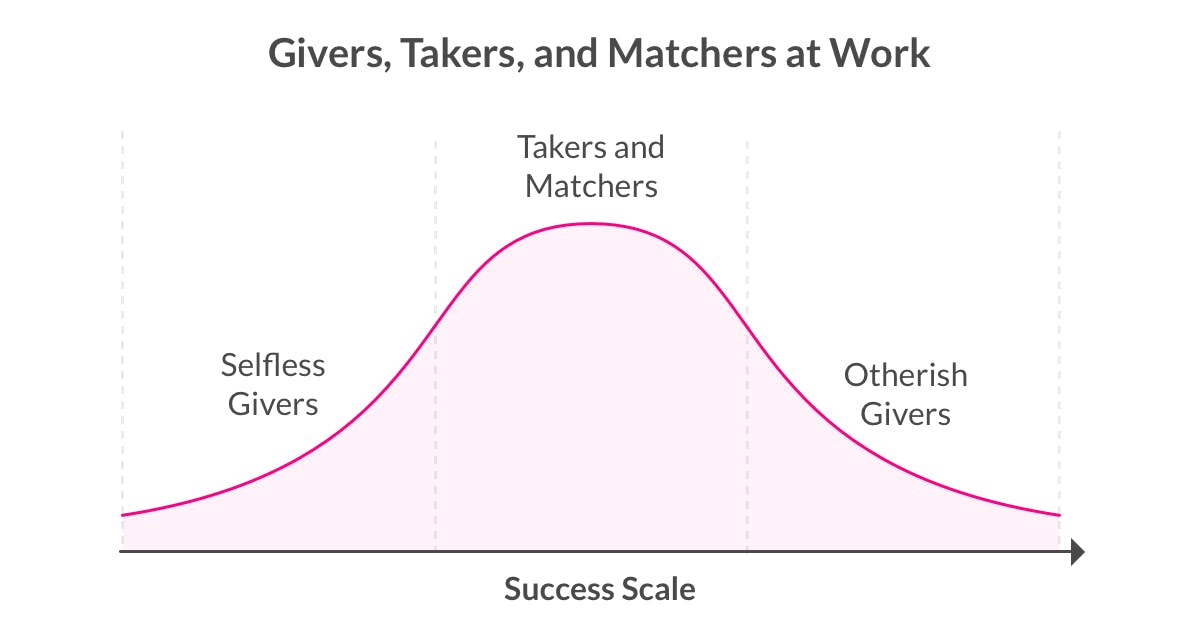
Under this premise, I’ve considered how the giver | matcher | taker framework may translate into distributed or virtual teams. Is there the same proportion of each persona and does the act of working remotely sway people toward any particular behavior style?
While I don’t have data supporting this yet, I believe that there may be a sway in the taking direction while working remotely. This is not just in the case of freelancers, but across core teammates as well. Let me explain why I think this is:
Say that you work in an office. If we return to the unspoken values of said office, impact isn’t always king. There’s other factors at play, like facetime. Any office manager would like to say that impact prevails, but we all know from experience that you don’t want to be the first one out of the office. This in itself, supports the initial claim.
While everyone in an office has their own KPIs, they are similarly judged by the hours they clock in and their interaction within the community workplace. As most are, this community is somewhat self-regulating. For example, if someone chooses to spend some of their face time staying late and helping a coworker out with their problem, that’s “+5 bonus points”.
Everyone knows who the team players are in an office.
With no “face time," remote companies naturally rely solely on “impact” and clear KPIs to judge their employees. This makes sense. But how does that impact someone’s natural inclination to support others, both within their function and across the company?
I believe the remote equivalent of “staying late”, perhaps helping someone complete a project or doing work that doesn’t directly impact your KPIs, is diluted and less likely for two key reasons:
1. With no set hours, "staying on for longer" is difficult to quantify. More importantly, any help that you do provide outside of your core responsibilities is represented only through personal [Slack] messages. Of course, people shouldn’t help others only to be “seen” as givers, but it’s only natural that as givers are not recognized for their giving behavior, they may inch toward something that Grant defines as “giver burnout”. I’ve seen this happen throughout my years working remotely and not necessarily to anyone’s fault, but perhaps the lack of systems in place to recognize and champion these hidden givers in distributed organizations.
2. Moreover, since individuals in remote organizations are more likely to have individual KPIs to meet, they must balance their ambition to help others with their performance. Working towards a quarterly raise versus helping another person who will be the sole witness for your actions isn’t an easy ongoing decision, even for the most giving individual.
In other words, regardless of your intentions, values, or morals, when you have the unconscious choice between your KPIs and helping another who will likely be the only one aware of your actions, I think less giving is naturally going to happen.
Give and Take: Best Practices
Since we can all testify that giving is not inexistent across remote teams, what am I really trying to say here?
I’m saying that remote workforces and particularly remote team leads should be hyperaware of this lack of “water cooler”, not just for community building, but for ensuring healthy collaboration dynamics.
Although I don’t have a comprehensive solution, here are a few starting points:
- Ask your team who helped them that particular week or month.
- Intentionally build KPIs that encourage teamwork or potentially can only be achieved through teamwork.
- Start a Slack #shoutouts channel to acknowledge the hidden givers at the organization while also openly celebrating and therefore encouraging this behavior
I’m sure there are numerous other methods (please let me know if you have them!), but I think the key here is that companies operating remotely need to intentionally design systems to acknowledge these hidden givers before they lose them.
We need to expose giving behavior, since it doesn’t come automatically and it needs to be discrete; it needs to be tangible.
I would also encourage leaders and hiring managers to consider this framework during the recruiting process and actively seek givers. Grant has already identified which interview question that you need to add to your roster, in order to easily determine if someone is a giver:
“Can you give me the names of four people whose careers you have fundamentally improved?”
You can learn more here about why this question provides insight into a person’s giving tendency. Regardless, the core takeaway is to actively solicit more of givers into your organization as they will impact the social fabric of how others operate.
Remote Work Best Practice: Take steps to intentionally discover, hire, promote, and acknowledge givers in remote environments.
Algorithms to Live By - Where are the Boundaries?
Algorithms to Live By has quickly become one of my favorite books. Gifted to me by a [remote] teammate, this book identifies various ways that we can learn and take insight from computer science in order to better our lives.
Among topics like caching theory, how to make unsolvable (intractable) problems solvable (tractable), or effectively utilizing the concept of annealing – this book closes out with some thoughts on game theory and its ramifications on life.
One particular example covered in this context is the concept of the “unlimited vacation policy." While this “perk” is becoming more prominent across distributed companies, the authors point out that despite altruistic intentions, the policy ultimately fails to reach the intended goal of achieving additional employee satisfaction.
Why? There is a concept in game theory and economics called the Nash equilibrium. It is “a stable state of a system involving the interaction of different participants, in which no participant can gain by a unilateral change of strategy if the strategies of the others remain unchanged”. In simpler terms, it is the optimal outcome of a game when there is no incentive to deviate.
Perhaps surprising to some, the Nash equilibrium of an unlimited vacation policy is zero. Why? The natural tendency for employees is to want to take as much vacation as possible, while simultaneously taking slightly less than their peers in order to seem more dedicated.
We can see this play out clearly in data, gathered by Buffer’s State of Remote Report, which quantified the difference between how much vacation was offered by remote organizations versus how much was taken. Despite 32% of companies offering “unlimited vacation”, you can see that most of the individuals with this option opted to take two weeks or less.
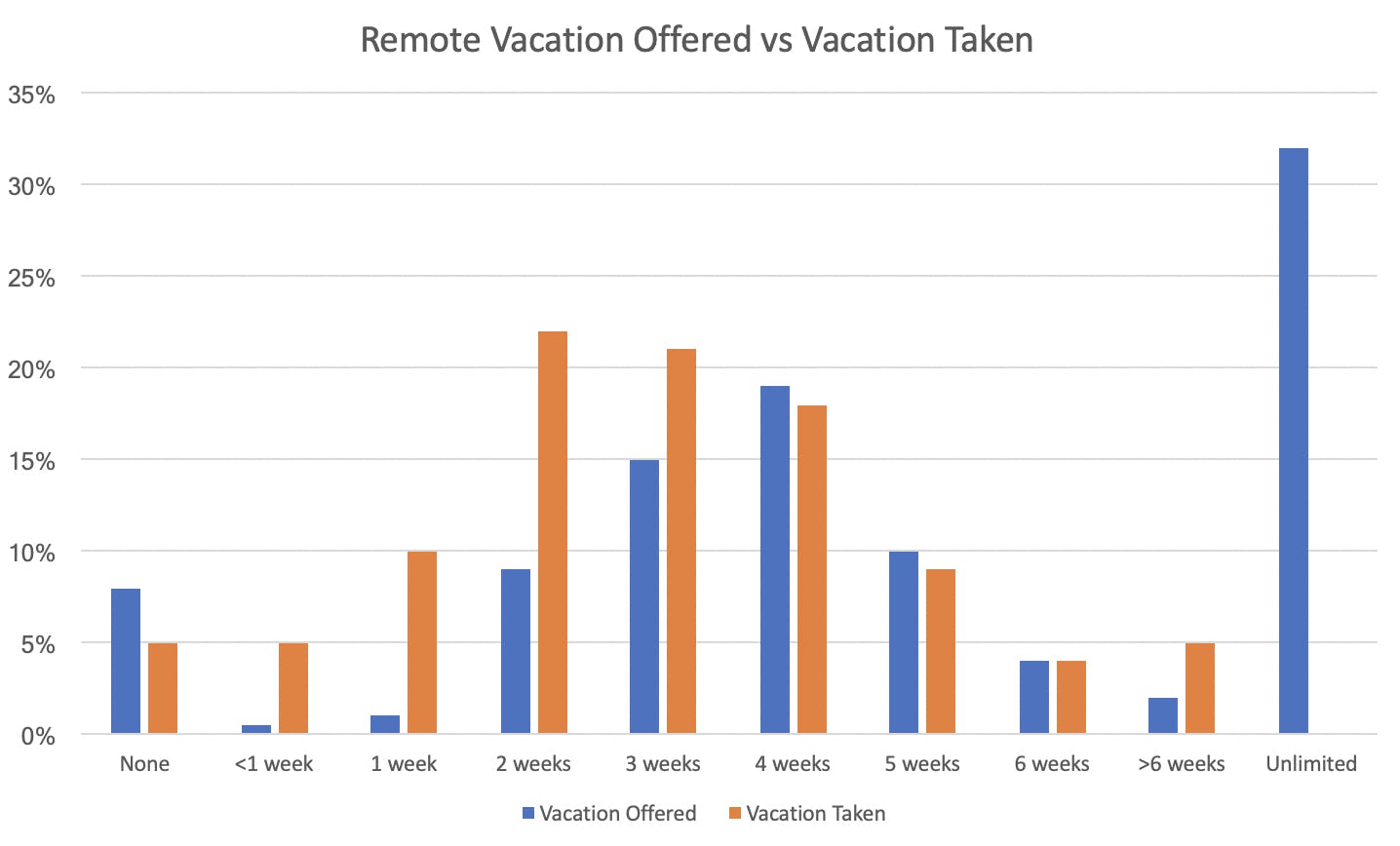
The same concept is similarly true for office hours. Employees truly want to leave at a reasonable hour, but certainly do not want to be the first to depart. So naturally, this psychology converges at some number (the Nash equilibrium) that each office thinks is acceptable, but often past what employees truly want.
Game theory teaches us that when all players act independently on their best course of action, this does not always result in the best course of action for the group: commonly known as the tragedy of the commons.
As “players” of the game, we can’t always do much to change the way the system operates, as you only have control over a single “player”. Instead, we must look to those defining the game to change it, through mechanism design. While game theory focuses on asking which behaviors emerge from a given set of rules, mechanism design does the opposite. It seeks to understand the rules that need to be developed to generate the behavior that is being sought out.
Algorithms to Live By: Best Practices
The above information begs the question once more regarding how remote leaders should consider setting their KPIs or policies. We cannot simply copy and paste the set of rules from a typical workplace and just assume they’ll produce the results we’re looking for, especially since remote work can be integrally more vague.
For example, the same Buffer study indicated that the #1 difficulty for remote workers is not being able to unplug, topping things like loneliness, motivation, and even the lack of vacation time which we discussed above.
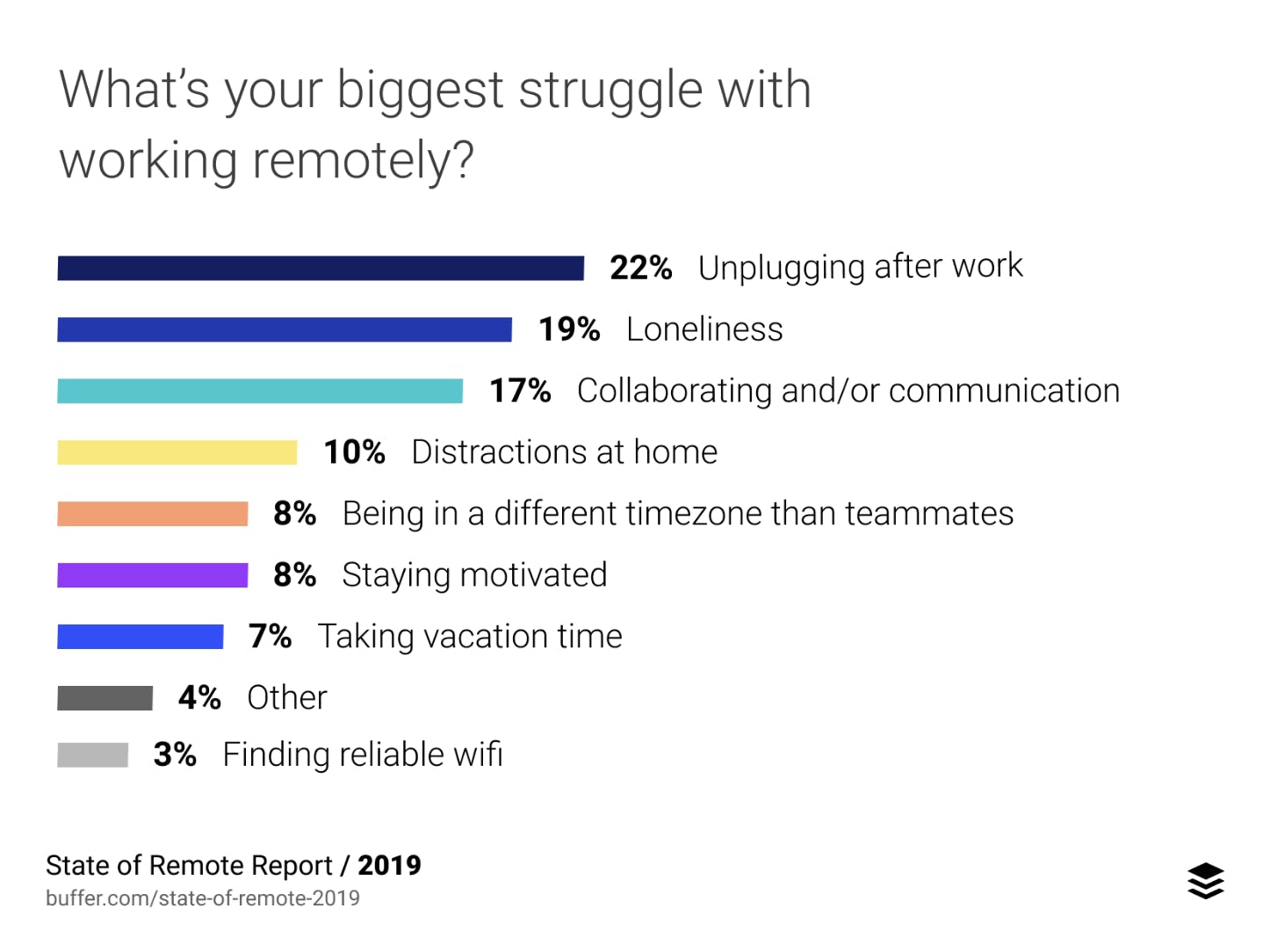
Remember, if we don’t intentionally design, we start to see the Nash equilibrium of virtual work hours become abnormally high, where remote workers essentially don’t know how or when to switch off. Currently, individuals are left to define these limits for themselves. So, I would opt toward mechanism design and ask those leading remote teams this question:
Are you actively designing KPIs or rules to encourage a life-work balance outside of the “freedom” given to define your own?
Instead of looking for the best ways to “manage” distributed teams, perhaps we should think about the ways that we design beneficial outcomes instead. Leaders should think backwards and intentionally design rules that not just encourage, but cause those actions. In this case, intentionally setting up structures that cause an individual to act in ways that are beneficial to both themselves and the commons.
This is where, contrary to the autonomy which is so welcomed in the remote world, it may be beneficial to consider adding back some more administration. Positive administration of course, to ensure that you’re truly designing the remote workplace to foster positive outcomes.
For example, implementing:
- A “minimum vacation policy”
- A mandatory set of holidays to take off
- A system that allows employees to “take back their calendars” and avoid calendar Tetris
- Facilitating open discussions about how to work remotely effectively and successfully
I recently saw one great example of this, where a leader made it mandatory for his team to take off a particular Friday and rewarded them with $50 to go to their favorite restaurant.
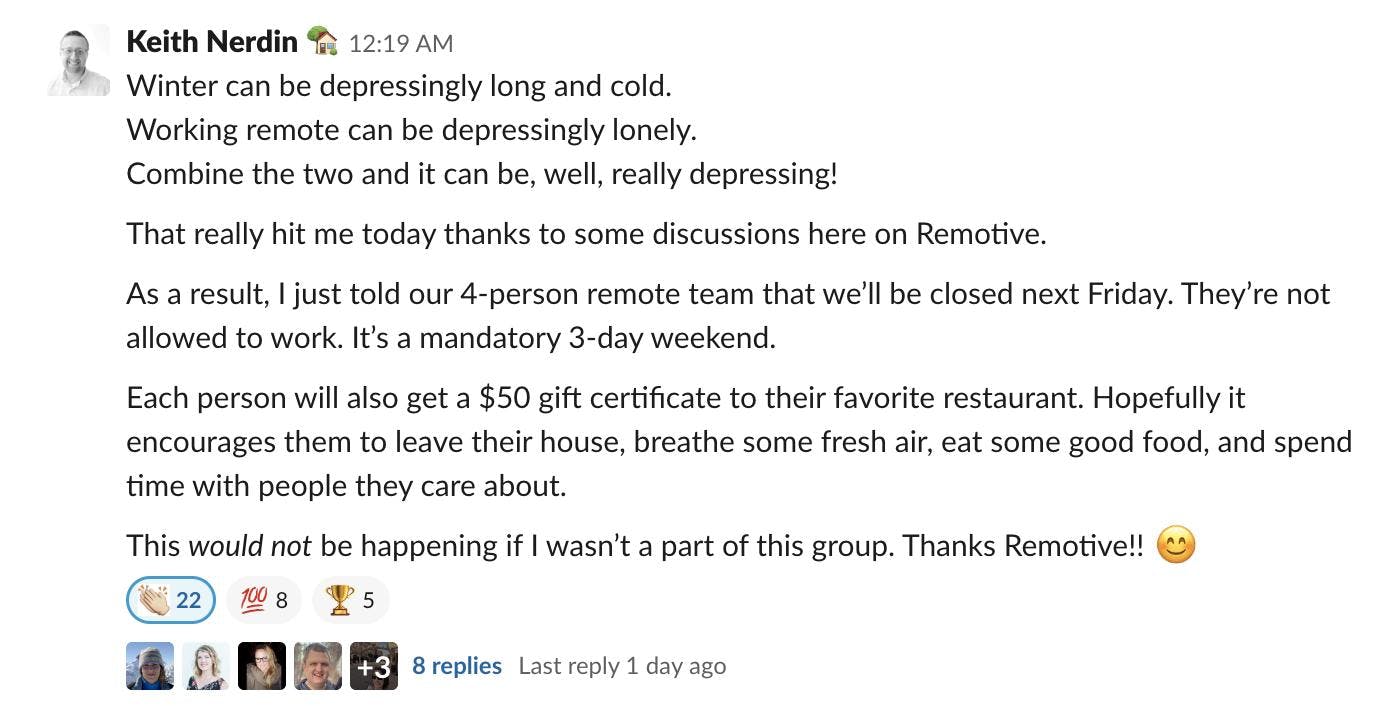
The point here is that things cannot always be enforced through carrots and as our workforce becomes less binary, intentional “mechanism design” becomes more important. Consider that even Wall Street, of the most capitalist hubs, has mandatory “off hours” so that brokers don’t push towards the infinite, sleepless Nash equilibrium.
With few restrictions, remote work has the potential to be productive, healthy, and optimal, if the right game is designed. So let’s actively design it.
Remote Work Best Practice: Design systems which enable people to easily act in beneficial ways. This may mean some degree of positive administration which did not exist before.
The Four Tendencies: Do You Know Your Team?
A Hypothesis: “The happiest, healthiest, most productive people aren’t those from a particular Tendency, but rather they’re the people who have figured out how to harness the strengths of their Tendency, counteract the weaknesses, and build the lives that work for them.”
Gretchen Rubin has developed an insightful framework called The Four Tendencies, which effectively captures how people respond to expectations. Ultimately, these tendencies have a close relationship with how we make decisions.
The framework’s tendencies include the Upholder, Questioner, Rebel and Obliger, with overlap between adjacent tendencies. The allocation of a particular tendency is represented by one’s response to inner and outer expectations.
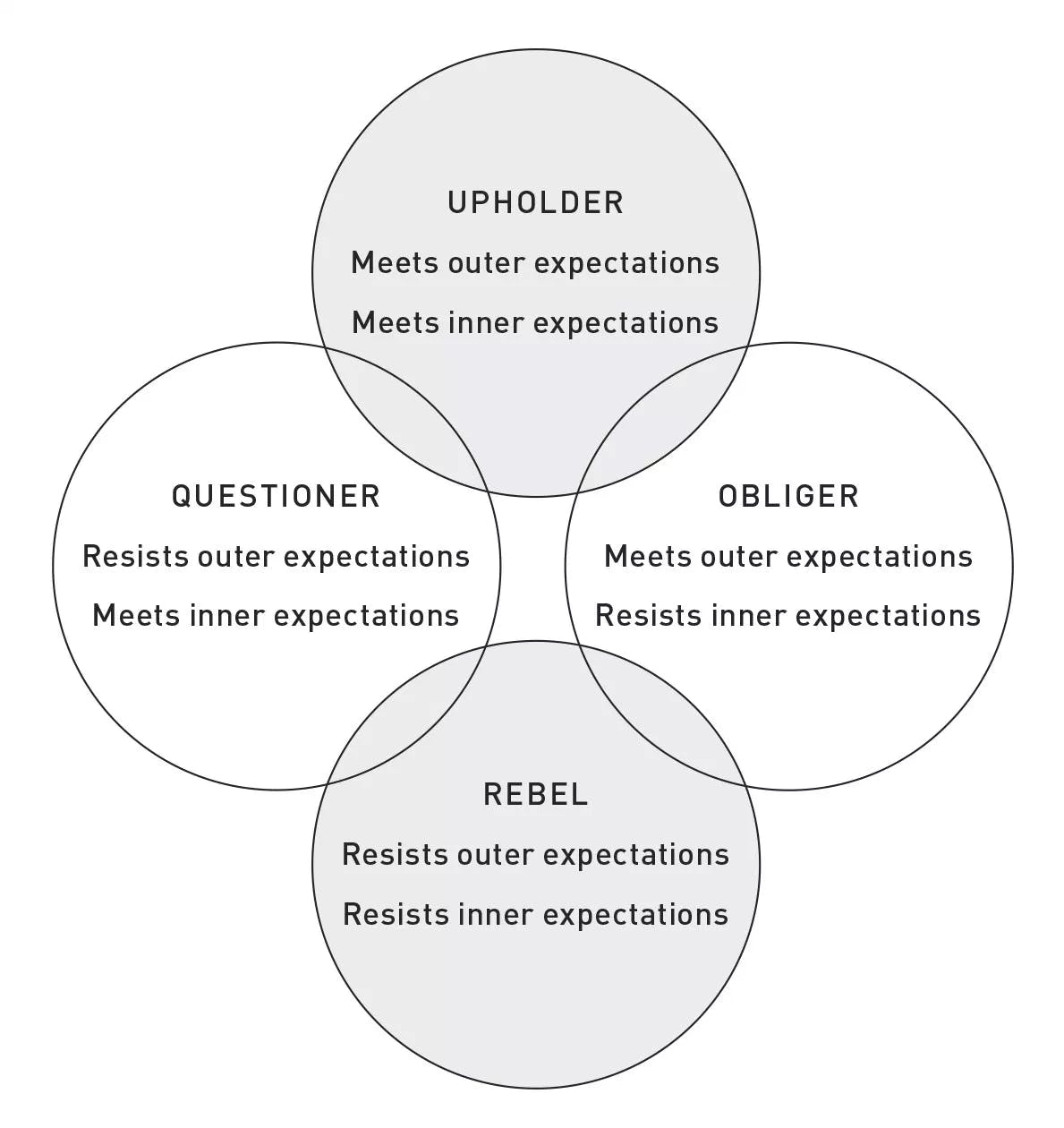
Although the Four Tendencies framework itself is certainly not scientific or even quantifiable, I do believe there are some takeaways that permeate into remote environments. As a questioner, I’ve found great value in understanding that I’m motivated by internal expectations, while struggling to meet external expectations.
Naturally, I questioned whether there was a trend across remote workers, based upon self-selection. Since there is rarely someone pushing you to work remotely, I suspected that those who are less externally accountable and more internally accountable may more often work remotely.
Questioners and Rebels
According to Rubin, the two most common tendencies across the wider population are:
- Questioners
- Obligers
“Of the Four Tendencies, my research shows that most people are either Questioners or Obligers — and Obliger is the largest Tendency of all (for both men and women). Of the Four Tendencies, Rebel is the smallest category, and Upholder is also a small category. Not many people are Rebels or Upholders.”
I decided to conduct this research myself, through a Twitter poll of over 400 remote workers.
The results?
By far, the two most prominent tendencies were:
- Rebels (40%)
- Questioners (37%)
What went from the least common tendency skyrocketed to the most common across remote workers. And perhaps more interestingly, over ¾ of respondents fit into the two categories with a common thread: resisting outer expectations. If we take this data at face value, that means that there are more than 3x as many rebels and questioners as compared to upholders and obligers in the remote workforce.
To me, this wasn’t surprising at all. Those who actively self-select, identify that “there is a better way”, and then proceed forward to go and redesign their way of living. I hypothesize that they choose this out of:
1. A misalignment with the outer expectations of society at least in terms of work norms
2. An internal vision and motivation do find something better
For these reasons, while there is no doubt that all four tendencies are represented in distributed teams, this disproportion seems to “add up”.
The Four Tendencies: Best Practices
I recently published an article which touched on this analysis lightly and got some backlash from Upholders and Obligers who were successful remote workers. To be clear, just like any type of job, I think that all four tendencies can be successful in nearly any work environment. I simply think there is a greater distribution of questioners and rebels as they actively seek this environment out. In other words, I don’t think upholders and obligers feel the same “pull” into remote work as they can satisfy external expectations in more typical work environments.
So what are the core takeaways here? Remote employees seem to fall within certain tendencies more frequently. With that knowledge, leaders should be able to tailor their leadership styles to understand and motivate their employees more effectively. For example, instead of instilling outer accountability through deadlines or repercussions, emphasize why a task is important to a questioner.
On a wider scale, if companies want the "best talent", they should embrace that significant chunks of the workforce operate better when they can design their own lives. In many ways I feel as though this data validates that working remotely is not about relaxing, but questioning or rebelling from societal structure and then looking to redefine/optimize.
Remote Work Best Practice: Learn about the motivation styles of your team members and tailor your leadership to be most effective for them.
Onward and upward
With the workforce evolving quickly, it’s not enough to just remove the office and CTRL+C, CTRL+V the existing approach. While embracing remote work with open arms, we should also have a critical eye for enduring that we truly create the best possible outcomes for both individuals and companies. Perhaps if we were more open to address some of these problems at the root instead of putting perk bandaids on top, we’d have to worry less about how to motivate, keep, or engage remote employees.
To summarize, if you’re building a remote team or company, consider how you can introduce more givers or encourage giving behavior. Consider how you can design flexible working practices or rather, restructure the “game” so that its oriented to achieve the best outcomes that are best for all (ie: find the right Nash equilibrium). Finally, consider that everyone is unique, but your remote team or company may over-index in certain tendencies. Acknowledge this and enable your team to thrive by supporting their affinity to specific expectations or assisting them to harness their unique strengths.
The values of remote work: output, autonomy, and flexibility are powerful. Let’s make sure to embrace them with care and build stronger, yet more self-aware organizations.
This post originally appeared on Steph Smith's blog.
Comments (28)
edward henry@edward_henry3
Petbarn Promo code is best code provided by Petbarn . Amazing Discount Offers, Get Petbarn & Promo Codes and save up to 25% Off the offer, so get the code helps you to save on coupon and promo codes.
https://uttercouhpons.com/front/...
Share
Definitely! You are absolutely right. Remote work has a number of powerful benefits, including output, autonomy, and flexibility. Our focus should be on embracing them with care while building a stronger, yet more self-aware organization. Our Boss also done this remote work practice serious apply in our Company https://leatherings.com
Really nice and interesting post. I was looking for this kind of information and enjoyed reading this one. Keep posting. Thanks for sharing. https://www.celebjacket.com/prod...
Transform your home effortlessly with (Splendas) https://splendas.com luxury decor. Crafted with style and sophistication, our collection offers timeless elegance and unparalleled refinement for your living space.
Good day! This post couldn't be composed any better! Perusing this post helps me to remember my old fashioned flat mate! He generally continued discussing this. I will advance this review to him. Almost certain he will have a decent perused. Much obliged for sharing!
https://www.jacketars.com/produc...
More stories

Mathew Hardy · How To · 3 min read
How to Detect AI Content with Keystroke Tracking

Sanjana Friedman · Opinions · 9 min read
The Case for Supabase

Vaibhav Gupta · Opinions · 10 min read
3.5 Years, 12 Hard Pivots, Still Not Dead
Kyle Corbitt · How To · 5 min read
A Founder’s Guide to AI Fine-Tuning

Chris Bakke · How To · 6 min read
A Better Way to Get Your First 10 B2B Customers
